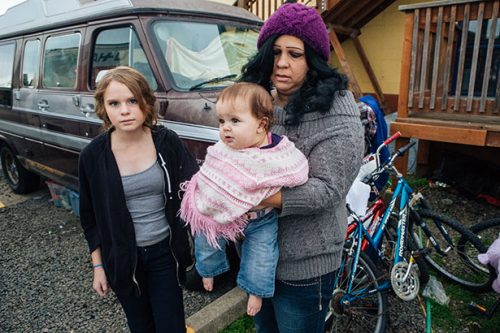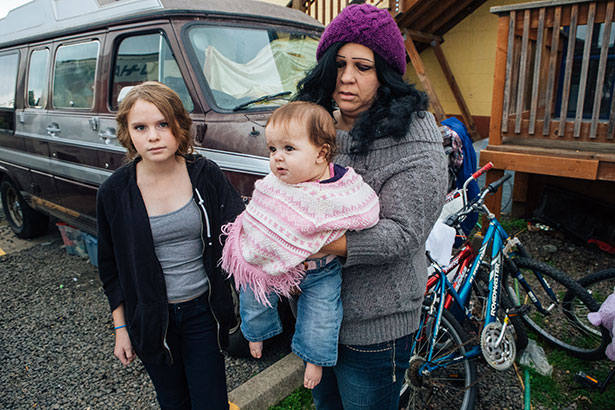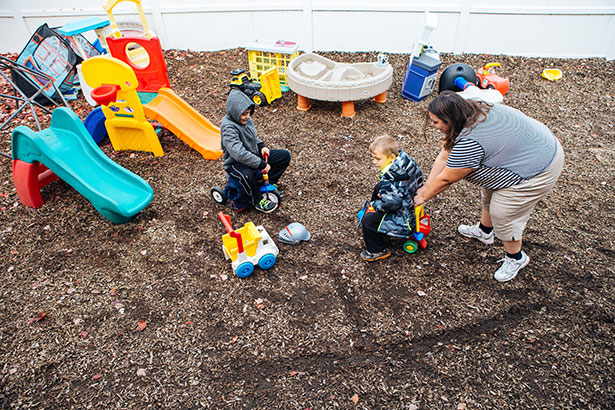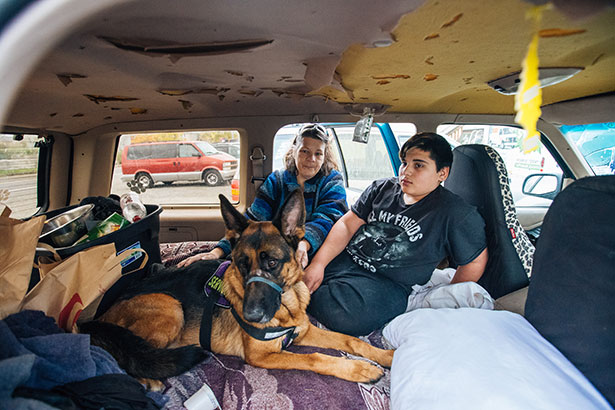
 |
| Robin Calhoon stands in front of the Family’s van with baby Prema and daughter Indra. Photo by Todd Cooper. |
Indra cuddles up every night in the passenger seat of her family van. A mountain of library books and drawing pads are stacked on the console next to her little bed, which is veiled from the outside world by a baby blanket draped over the door window. Each night, her mother, two sisters and brother also stretch out beside her in the quiet van, sleeping on the piles of clothes that cushion the seats.
Indra was 12 when her mother announced the family would be driving from Pennsylvania to Eugene. Excited, Indra immediately called shotgun for the road trip. They arrived in Eugene five months ago in June, their dog and three-week-old baby sister Prema in tow.
Now 13, Indra still sleeps every night in that shotgun seat, as the family has yet to find housing here.
Indra joins the other 2,148 homeless children counted throughout Lane County’s various school systems for this past school year, according to the Oregon Department of Education. That figure does not include younger children not yet attending school.
The specter of parents struggling to raise children while living in a van or tent is a rising epidemic in Lane County. The alarming realities of unpaid child support and an outdated, underfunded Oregon welfare system, combined with a soaring cost of living, are shoving many already-poor families into homelessness. All you need is a back injury, a job loss or maybe a divorce to get behind on your rent, and the cold streets are more than willing to meet your fall.
Staff at First Place Family Center, a day shelter for families with children located on Amazon Parkway, say their monthly numbers are climbing each month. They served 241 families in September, compared to 203 families in September of last year.
“We’ve had more people to serve every month than the month before,” First Place Family Center’s director William Wise says. “They just go up and up and up,”
The number one reason for homelessness in Eugene and Lane County is its terrible housing market, Wise says.
“Our housing market is awful for rentals,” he says. With about 80 percent of the UO undergraduate population off-campus, according to U.S. News and World Report’s educational rankings, families find themselves competing for housing against students. Landlords, Wise says, are far more willing to rent to a single person with no children or criminal history than a five-person family, some of whom may have a felony or two on their record.
“That drives the market up and makes it harder to get in,” he says.
Indra’s mother, Robin Calhoon, signed up for the Lane County housing list as soon as the family arrived last June. She called the county office each week to check her ranking on the housing list.
On Nov. 5, after showing up 5th on the list after five months of waiting, the office informed Calhoon they had changed their housing policy and her family was no longer eligible because they hadn’t been homeless for 12 or more months.
“I’m upset, because I did everything they say to do,” Calhoon says.
Partially in response to the country’s housing crisis, Lane County Human Services in early November erased the eligibility of 319 out of 394 homeless people on the county’s central housing waitlist. By changing the housing criteria to apply only to the chronically homeless, Human Services lifted some of the most urgent cases to the top of the list, but left many hundreds of people out of options.
First Place Family Center had 47 families in its caseload dropped off the list.
 |
| Karol Green plays with her children at First Place Family Center. Photo by Todd Cooper. |
SINGLE MOTHERS AND OREGON’S DERELICT WELFARE SYSTEM
Single mom Karol Green arrived two weeks ago at First Place’s day shelter with her two boys, 6 and 8, from Lakeview, Oregon. From August until the end of October, the three were sleeping in Green’s truck around Eugene, but transitioned to the shelter’s night program at the end of October.
Six-year-old Dylan says he knows they are at a shelter. Other children clamor around the lunch tables during the interview. Siblings push their younger brother or sisters around in overloaded strollers.
It’s noisy in here. Within the melée of children and parents, almost everyone has caught the same cold from being in close contact, sharing the communal kitchen, three computers and the playroom.
“It’s definitely a shelter, because if you are homeless, you go there,” Dylan says, shyly pushing his head into his mother’s arms. “I don’t have a house and I can’t get a puppy,” he says before scampering off to play with his older brother. Moments later, he returns crying, because Jack “won’t play with me.”
Green starts crying, too.
“We had to sell his puppy earlier this summer. It was just too hot in the truck,” she says, scrolling through photos of the little white dog on her cell phone. Green says all three of them are experiencing behavioral reactions to the stress and unpredictability of their situation; Dylan now wets his bed and, a few nights prior, he started refusing to go into the shelter bathroom without her.
Green became homeless several months ago after trying to move to Eugene from Lakeview for a new job. In Lakeview, the family was on Section 8 housing (a type of subsidized government housing). Green transferred her housing status to Eugene and moved here with the kids in July, only intending to stay in the truck a few weeks. But the boss at her new job kept holding her paychecks as she worked and eventually stopped paying her altogether. He continued to maintain, though, that he was paying her.
Without enough money to make the deposit on the new Section 8 apartment in Eugene, and without knowing there are programs in town that help pay for that, Green ran out of the 90-day limit to pay the deposit.
She’s now at the mercy of the housing crisis that the First Place staff is witnessing, as each month more families pour into the day shelter. Green called the Oregon Temporary Assistance for Needy Families (TANF) office to apply for welfare funds, but she says the same boss told the caseworker that he was still paying her. That single phone call has shut Green out of any TANF money.
The statistics connecting homeless parent/child families, child support and TANF in Lane County are spotty at best. EW obtained state records for homeless students attending school in Lane County (2,148), the number of single-parent families owed back payments on child support in Lane County (10,502 out of 14,968 cases in the past year) and the number of single-parent families on TANF in Lane County for the past year (2,034, with 1,742 of those in Eugene/Springfield).
After that, though, the figures get murky. The Oregon Department of Justice’s Child Support Program reports that of the 14,968 child support cases in Lane County, 2,122 of those families — typically single mothers — received TANF in the past fiscal year.
However, the TANF office, within the Department of Human Services, told EW that just 360 families on TANF in Lane County are receiving child support for the past fiscal year. DHS staff says the two offices, DHS and DOJ, may count child support payments differently, but couldn’t specifically explain the major discrepancy in the figures.
The statistics on the overlap between TANF and homelessness are equally unclear. Of the 2,034 single-families on TANF in Lane County, the DHS office says 52 families self-reported themselves as homeless.
“One caveat is that this is based on self-reporting and what the case manager actually puts in the system,” says Xochitl Esparza, state program manager for TANF with DHS. “If someone is living with relatives and they are temporarily there and they haven’t indicated to us they are homeless, it probably won’t be captured that way. It could be under-reported, but we can’t tell for sure.”
Green says she doesn’t receive child support from the father of her two boys. She says she fills out the paperwork from the state, but “more paperwork” always comes back. “I never get new paperwork on the father. It’s all the same basic paperwork,” she says.
Dylan’s father left while Green was pregnant, abandoning her and her two-year-old son.
Aside from the difficulty obtaining TANF funds in the first place, the Oregon state Legislature hasn’t changed its income rate for eligibility for TANF since 1991, meaning families each year essentially have to earn less and less money to qualify for TANF at all. The income limit is $616 per month for a single parent with two children in Oregon, so any parent earning even a few dollars more can’t get TANF.
A family on that salary today is earning just 37 percent of the U.S. federal poverty level; in 1991, they would have been earning 66 percent of that level, according to a report by the Oregon Center for Public Policy (OCPP).
The outdated, 24-year-old income limit has forced more and more families off TANF in Oregon. Lane County had 2,034 single-parent families on TANF in October 2015, down from 2,358 in October of last year. While fewer people on TANF might look good on paper, it actually means fewer people qualify for funding each year because of the outdated income limit.
“Today, a single parent of two who works two days a week at minimum wage (15 hours) makes too much to get help … in 1991, when that limit was first put into effect, a parent of two working nearly 30 hours per week at minimum wage could receive assistance,” according to OCPP’s anti-poverty report.
“We know it affects families. It makes it a lot more difficult to make ends meet when you have to be so poor to qualify for the program,” Esparza says. Another reason for the decline in TANF cases, she adds, is that Oregon’s economy has improved in the past three years, meaning more parents have been able to find work.
Compared to the rest of the state’s caseloads for TANF, the Lane County district comprises 12 percent of total state cases; the Portland area comprises 24.4 percent and the Salem area comprises 14.9 percent.
To change Oregon’s TANF situation, Esparza says the Oregon Legislature would have to pass a bill changing the income limit or increasing TANF payments to families.
Earlier this year, the Legislature’s House Bill 3535 changed some of the exit requirements for the program, enabling people who find employment to stay on TANF a little longer as they get back on their feet. Another part of the bill devotes some funding to extra childcare for the single parent.
 |
| Rhoda and Ezekiel Chavez with her service dog. Photo by Todd Cooper. |
CHILD SUPPORT: A GHOST STORY
Another woman using the day shelter, Rhoda Chavez, 48, is here with her 14-year-old son, Ezekiel. Chavez has successfully applied for TANF funds for Ezekiel. She gets $228 a month. Chavez is also legally blind and on disability, getting $563.
The two are at the shelter because, after moving here from Roseburg to receive sustained medical treatments for an emergency surgery, Chavez discovered she couldn’t afford to pay the high rent prices of Eugene.
“It’s an epidemic,” she says, gesturing at the other families with children playing in the shelter’s day room. “I feel like the economy has gotten so bad.” Rhoda’s husband left 12 years ago after being married a year. Because the man moves around as a migrant worker, the state has never successfully been able to track him for child support payments. Chavez relies solely on her disability and TANF check.
Of the 14,968 child support cases for both Division of Child Support offices in Lane County between July 2014 and July 2015, 10,502 of those cases (70 percent) have “arrearage,” meaning the parent is behind on their payments. And 6,800 of those 10,502 cases had some payment toward the arrearage in the same year; 3,702 cases received no payments for the past-due balance.
“If individuals are close to the bottom of their self-support reserves, they might not make payments to their arrears. It could sit there for years,” says Erin McDaniel, statistics manager for the Child Support Program of the Oregon Department of Justice.
While there are no concrete statistics linking homeless parents to a lack of child support in Lane County, First Place Family Center reports that of the 376 families they served over the past three months (October, September and August), 188 of those families were single-parent. Of the 376 families, just 17 parents say they are receiving child support.
Considering about half the families at First Place are homeless or couch-surfing, it’s safe to say the lack of child support or parents behind on payments could play a critical role on whether a family stays housed.
When asked if many of those 188 single-parent families were women, Wise throws up his hands and shakes his head.
“It’s way more women than men,” he says. “If a marriage breaks up, the guy does OK and the woman crashes.”
GETTING IN AND GETTING OUT: FAMILY STAYS HOPEFUL
Thirteen-year-old Indra and her family’s arrival into homelessness follows a narrative arc that the staff at First Place knows all too well. Last year, Indra’s mother Robin Calhoon hurt her back and couldn’t get enough sick leave at her job as a manager at Spencer’s store in Pennsylvania. She was fired. Her husband moved to California in March of this year to find better pay to support their family, working in landscaping. He is currently saving up money to get the family an apartment in Eugene.
In the meantime, Calhoon was pregnant with their fourth child, Prema, and struggling to take care of her other three children (Indra, a 17-year-old son and a 20-year old daughter) while on unemployment.
After that, their story is a blow-by-blow of bad luck. Calhoon’s mother died, leaving them no alternative place to stay. Her unemployment ran out. Then she gave birth to Prema in May 2015. They got behind on the rent for their house.
“In Pennsylvania, I could not be homeless with my kids because they would take them away from me,” says the mother of four, softly, as she jogs baby Prema on her knee in a back room at the First Place Family Center. The five-month-old bounces happily, oblivious to the shelter’s noise and her mother’s sadness.
Despite everything, Indra has made a friend at the shelter — at a recent visit to First Place, the two were gleefully running around in pastel makeup and glitter. She likes to play tag in the parking lot with another friend. Indra dreams of being an actor when she grows up. She dressed up as a cow for Halloween, after a friend in Pennsylvania sent her a rubber cow costume in the mail. She says she wants to see her daddy again soon when he comes up from California.
Help keep truly independent
local news alive!
As the year wraps up, we’re reminded — again — that independent local news doesn’t just magically appear. It exists because this community insists on having a watchdog, a megaphone and occasionally a thorn in someone’s side.
Over the past two years, you helped us regroup and get back to doing what we do best: reporting with heart, backbone, and zero corporate nonsense.
If you want to keep Eugene Weekly free and fearless… this is the moment.